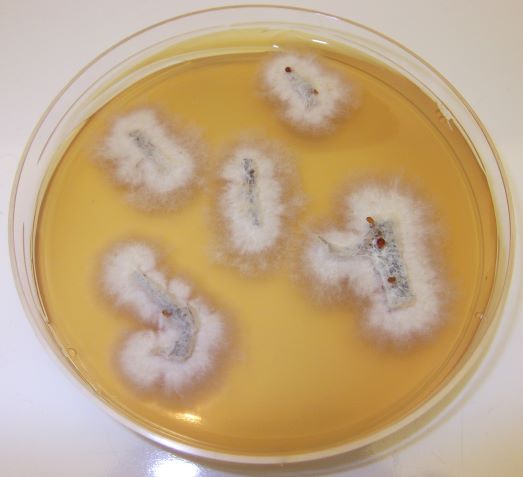Please click here to access the main AHDB website and other sectors.
- Home
- Knowledge library
- Monitoring Trichoderma aggressivum in mushrooms
Monitoring Trichoderma aggressivum in mushrooms
If you suspect Trichoderma aggressivum in your crops, it’s important to start testing right away. Read on to learn about monitoring methods.
Any outbreak of Trichoderma aggressivum is bad news for growers. It’s a fast-moving and destructive disease, so you’ll need to monitor crops closely and test quickly if you think there’s an infection.
Methods of testing
There are several ways to test for Trichoderma aggressivum.
For compost testing, it’s important to obtain a representative sample. It’s critical that this is thoroughly mixed before subsampling for testing.
The real-time PCR test has the quickest sample turnaround time and shows the level of the infection, making it the best detection method for high-risk situations.
Air fall-out plates positioned close to the tunnel doors during emptying pick up spores transmitted on dust particles and compost fragments. This is a cheap and reliable detection method, but we recommend backing up a positive Trichoderma result with a real-time PCR to confirm.
Sampling locations for compost facilities
Here are some recommendations for collecting compost or debris samples for testing:
- Sample Phase 3 compost from tunnel being emptied, taken off the conveyor
- Accumulated debris on the conveyor structure
- Debris taken from the back and sides of the emptying winch
- Debris material from around the supplement mixer, if appropriate
- Debris from the ground adjacent to truck-filling/dispatch area
- Debris from the back of the truck being filled
- Accumulated debris from the general dispatch area
- Debris from a second (returning) truck waiting to be refilled/dispatched
Air plate locations:
- Beneath the entrance to the tunnel being emptied
- On the emptying winch
- Close to where supplement is being added, if appropriate
- In the dispatch hall close to the truck-filling area
Sampling locations for grower facilities
Take samples in all growing rooms where there are symptoms, as well as in any freshly filled rooms. More than one sample may be taken in the office or canteen, depending on the size or contents.
Here are some locations for swab testing or collecting compost or debris samples:
- Swab of interior door and floor in growing room
- Swab of shelving
- Debris in growing room
- Sample of compost at any visible infection
- Swabs of canteen and office areas
- Swab of equipment (forklift, casing mixer, filling head)
- Debris on equipment and in the yard
- Swabs of staff hands/clothes/boots
Useful links
Find out the symptoms of Trichoderma aggressivum
How to manage Trichoderma aggressivum
Images are courtesy and copyright of: Mairead Kilpatrick (AFBI), Johan Baars (C4C Holding), Piet Liempens (Hooymans Compost BV), Brendan Burns (Sylvan) and Roland Mumm (Wageningen UR)

An example of routine monitoring procedures for Trichoderma aggressivum using simple compost fragment plate tests

